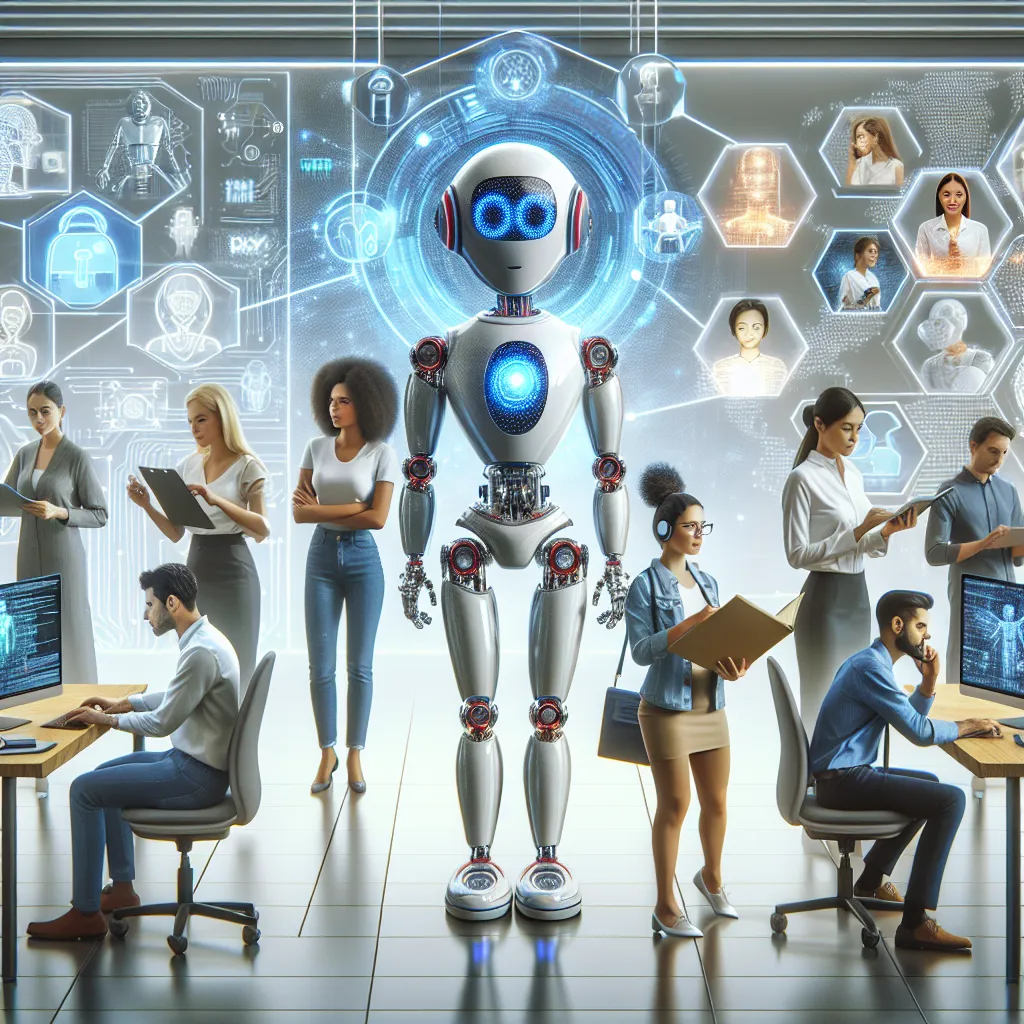As an experienced IELTS instructor, I’m excited to share a comprehensive reading practice focused on the topic “How automation is reshaping the labor market.” This practice will help you prepare for the IELTS Reading test while exploring a crucial contemporary issue. Let’s dive into the passages and questions that mirror the actual IELTS exam structure.
 Automation reshaping labor market
Automation reshaping labor market
Passage 1 (Easy Text)
The Rise of Automation in the Workplace
Automation has become an increasingly prominent feature of modern workplaces. From factories to offices, machines and algorithms are taking on tasks that were once performed exclusively by humans. This shift is driven by advancements in technology, particularly in the fields of robotics and artificial intelligence (AI).
The impact of automation on the labor market is multifaceted. On one hand, it has led to increased productivity and efficiency in many industries. Machines can work tirelessly, with precision and speed that often surpass human capabilities. This has resulted in lower production costs and improved output quality in manufacturing sectors.
However, the rise of automation has also raised concerns about job displacement. As machines become capable of performing a wider range of tasks, some workers find their skills becoming obsolete. This has particularly affected routine and repetitive jobs, such as assembly line work and data entry.
Despite these challenges, automation is also creating new job opportunities. The development, maintenance, and operation of automated systems require skilled workers. This has led to a growing demand for professionals in fields such as software engineering, data analysis, and robotics.
The future of work in an automated world is likely to involve a significant shift in the types of skills that are valued. Creativity, critical thinking, and emotional intelligence are becoming increasingly important, as these are areas where humans still have a clear advantage over machines.
Questions 1-5
Do the following statements agree with the information given in the passage?
Write
TRUE if the statement agrees with the information
FALSE if the statement contradicts the information
NOT GIVEN if there is no information on this
- Automation is limited to factory settings.
- Machines can work without breaks, unlike humans.
- All industries have seen lower production costs due to automation.
- Routine jobs are more at risk of being automated.
- Schools are changing their curricula to focus on skills needed in an automated workplace.
Questions 6-10
Complete the sentences below.
Choose NO MORE THAN TWO WORDS from the passage for each answer.
- Advancements in robotics and ___ are driving the shift towards automation.
- Automation has led to improved ___ quality in manufacturing sectors.
- Some workers find their skills becoming ___ due to automation.
- The operation of automated systems requires ___ workers.
- In an automated world, ___ and critical thinking are becoming more valuable skills.
Passage 2 (Medium Text)
The Transformative Effects of Automation on Employment
The inexorable march of automation is fundamentally altering the landscape of employment across the globe. As technology continues to advance at an unprecedented pace, industries are witnessing a seismic shift in their workforce requirements and operational paradigms. This transformation is not merely a continuation of past trends but represents a quantum leap in the way work is conceptualized and executed.
One of the most significant impacts of automation is the polarization of the job market. While it has led to the obsolescence of many middle-skill jobs, it has simultaneously increased demand for both high-skill and low-skill occupations. This phenomenon, often referred to as job market hollowing, has profound implications for income distribution and social mobility.
High-skill jobs, particularly those requiring complex problem-solving, creative thinking, and interpersonal skills, have seen a surge in demand. These roles, which often involve managing and interpreting the output of automated systems, command higher salaries and offer greater job security. Conversely, many low-skill jobs, especially in the service sector, have proven resistant to automation due to the need for human interaction and adaptability.
The manufacturing sector has been at the forefront of the automation revolution. Advanced robotics and AI-driven systems have transformed factory floors, dramatically increasing productivity while reducing the need for human labor in routine tasks. This has led to a shift in the skills required in manufacturing, with a greater emphasis on technical expertise to operate and maintain sophisticated machinery.
The gig economy has emerged as a significant feature of the automated labor market. Digital platforms have facilitated the rise of freelance and contract work, offering flexibility but often at the cost of job security and benefits. This trend has been accelerated by automation, as companies seek to maintain a more adaptable workforce in the face of rapid technological change.
Education and skill development have become critical in navigating the automated job market. There is an increasing focus on STEM education (Science, Technology, Engineering, and Mathematics) to prepare workers for high-skill roles. Additionally, there is growing recognition of the importance of soft skills such as adaptability, creativity, and emotional intelligence, which are less likely to be replicated by machines.
The impact of automation extends beyond individual job roles to affect entire organizational structures. Companies are reassessing their hierarchies and decision-making processes, often flattening management structures and empowering employees to work more autonomously with the support of automated systems.
As we look to the future, the challenge lies in harnessing the benefits of automation while mitigating its disruptive effects on employment. This will require a concerted effort from governments, businesses, and educational institutions to foster an environment of continuous learning and adaptation, ensuring that the workforce remains relevant and productive in an increasingly automated world.
Questions 11-14
Choose the correct letter, A, B, C, or D.
-
According to the passage, the impact of automation on the job market has:
A) Only affected low-skill jobs
B) Led to a decrease in both high-skill and low-skill jobs
C) Increased demand for high-skill and low-skill jobs while reducing middle-skill jobs
D) Only benefited high-skill workers -
The manufacturing sector has been transformed by automation through:
A) An increase in human labor for routine tasks
B) A reduction in productivity
C) The use of advanced robotics and AI systems
D) A decrease in technical expertise requirements -
The gig economy is characterized by:
A) Increased job security
B) More flexible work arrangements
C) Higher salaries
D) Traditional employment benefits -
The passage suggests that future success in the job market will likely depend on:
A) Focusing solely on technical skills
B) Avoiding any kind of skill development
C) Developing a combination of technical and soft skills
D) Specializing in manual labor skills
Questions 15-19
Complete the summary below.
Choose NO MORE THAN TWO WORDS from the passage for each answer.
Automation is causing a significant transformation in the global workforce. It has led to the 15) of the job market, with increased demand for both high-skill and low-skill jobs. High-skill jobs often involve managing automated systems and require complex problem-solving abilities. The 16) has been greatly affected by automation, with 17) changing the nature of work on factory floors. The rise of the 18) has created more flexible work opportunities but often with less job security. To adapt to these changes, there is a growing emphasis on 19)___ and the development of soft skills that are less likely to be automated.
Passage 3 (Hard Text)
The Socioeconomic Implications of Labor Market Automation
The pervasive integration of automation into the global labor market is engendering a paradigm shift that extends far beyond the realm of employment, permeating the very fabric of socioeconomic structures worldwide. This technological revolution, characterized by the proliferation of artificial intelligence, machine learning, and robotics, is not merely altering the nature of work but is fundamentally reshaping the relationship between labor, capital, and society at large.
The displacement of human labor by automated systems is occurring at an unprecedented scale and velocity. While historically, technological advancements have led to the creation of new jobs that offset those rendered obsolete, the current wave of automation poses unique challenges. The rapidity and breadth of technological change are outpacing the labor market’s capacity to adapt, leading to what economists term “technological unemployment”. This phenomenon is particularly acute in sectors traditionally reliant on middle-skill labor, contributing to a growing dichotomy between high-skill and low-skill employment.
The erosion of the middle class, a direct consequence of this labor market polarization, has profound implications for social mobility and income distribution. As automation disproportionately affects middle-income jobs, there is a growing concern about the widening income gap and its potential to exacerbate social inequalities. This trend is further compounded by the concentration of wealth among those who own and control automated systems, potentially leading to an unprecedented level of economic stratification.
The gig economy, while offering flexibility and entrepreneurial opportunities, also presents challenges in terms of job security and social protections. The rise of platform-based employment facilitated by digital technologies has created a new class of workers who often fall outside traditional labor regulations. This shift towards more precarious forms of employment raises questions about the adequacy of existing social safety nets and the need for new models of worker protection in an automated economy.
The impact of automation on the labor market is not uniformly distributed across demographic groups. Older workers and those with lower levels of education are particularly vulnerable to displacement, as they may face greater challenges in acquiring the new skills demanded by an automated economy. Moreover, there are concerns about the potential for automation to exacerbate gender and racial disparities in employment and wages, as certain demographic groups are overrepresented in jobs at high risk of automation.
The geographic distribution of the effects of automation is also uneven, with some regions experiencing more severe disruptions than others. Areas heavily dependent on industries susceptible to automation, such as manufacturing-centric regions, face the risk of economic decline and social dislocation. This geographic disparity has the potential to intensify regional economic inequalities and contribute to political polarization.
The education system faces the monumental task of preparing individuals for a rapidly evolving job market. There is a growing emphasis on lifelong learning and the development of adaptable skill sets that can withstand the pressures of automation. This necessitates a fundamental rethinking of educational paradigms, with a focus on fostering creativity, critical thinking, and emotional intelligence – attributes that are less susceptible to automation.
The role of government in managing the transition to an automated economy is becoming increasingly crucial. Policymakers are grappling with the need to balance the benefits of technological progress with the imperative of maintaining social cohesion. Proposals such as universal basic income, robot taxes, and comprehensive retraining programs are being debated as potential responses to the challenges posed by automation.
As we navigate this period of profound transformation, it is imperative to recognize that the impact of automation on the labor market is not predetermined. The ultimate outcomes will depend on the collective choices made by societies in response to these technological changes. Striking a balance between harnessing the productive potential of automation and ensuring equitable distribution of its benefits will be one of the defining challenges of our era.
Questions 20-23
Choose the correct letter, A, B, C, or D.
-
The passage suggests that the current wave of automation differs from historical technological advancements because:
A) It is creating more jobs than it eliminates
B) It is occurring at a slower pace
C) The labor market is struggling to adapt quickly enough
D) It only affects low-skill jobs -
According to the passage, the gig economy:
A) Provides better job security than traditional employment
B) Is not influenced by digital technologies
C) Challenges existing labor regulations and social protections
D) Only affects high-skill workers -
The text indicates that the impact of automation on different demographic groups:
A) Is uniformly distributed
B) Favors older workers
C) May worsen existing gender and racial disparities
D) Only affects those with higher education levels -
The passage suggests that the education system needs to:
A) Focus solely on technical skills
B) Maintain current educational paradigms
C) Emphasize rote learning
D) Develop adaptable skills and foster attributes less susceptible to automation
Questions 24-26
Complete the sentences below.
Choose NO MORE THAN THREE WORDS from the passage for each answer.
-
The displacement of human labor by automated systems is contributing to what economists call ___.
-
The rise of platform-based employment has created a new class of workers often not covered by ___.
-
Some areas heavily dependent on industries susceptible to automation face the risk of ___ and social dislocation.
Questions 27-30
Do the following statements agree with the claims of the writer in the passage?
Write
YES if the statement agrees with the claims of the writer
NO if the statement contradicts the claims of the writer
NOT GIVEN if it is impossible to say what the writer thinks about this
-
The concentration of wealth among owners of automated systems may lead to unprecedented economic stratification.
-
The gig economy provides better social protections than traditional employment.
-
Automation will inevitably lead to a more equitable distribution of wealth.
-
The role of government in managing the transition to an automated economy is becoming less important.
Answer Key
Passage 1
- FALSE
- TRUE
- NOT GIVEN
- TRUE
- NOT GIVEN
- artificial intelligence
- output
- obsolete
- skilled
- Creativity
Passage 2
- C
- C
- B
- C
- polarization
- manufacturing sector
- advanced robotics
- gig economy
- STEM education
Passage 3
- C
- C
- C
- D
- technological unemployment
- traditional labor regulations
- economic decline
- YES
- NO
- NO
- NO
This IELTS Reading practice test on “How automation is reshaping the labor market” provides a comprehensive exploration of the topic while testing various reading skills. The passages progress from easier to more challenging texts, mirroring the structure of the actual IELTS Reading test. By engaging with this material, test-takers can improve their understanding of complex economic concepts while honing their exam strategies.
For further insights into related topics, you might find these articles helpful:
- Impact of Technology on Job Automation
- How Automation is Transforming Global Industries
- Impact of Automation on Income Inequality
Remember, success in the IELTS Reading test comes from regular practice and developing effective time management skills. Good luck with your IELTS preparation!


